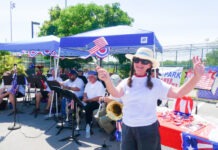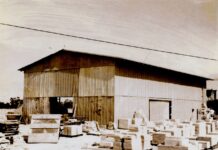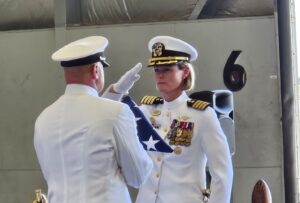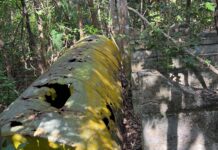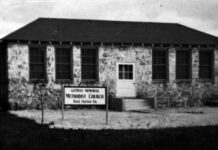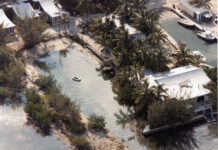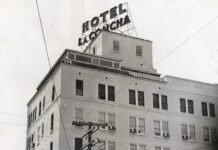John Jacob Housman was born in 1799 on Staten Island, New York. The son of an oysterman, he was one of nine children. As a young man, he became master of his father’s 56-foot schooner William Henry.
Much of the history of Housman’s young life has been left open for interpretation and revolves around the narrative that the young sailor grew bored with the “coasting and packet along the shores of Staten and Long islands, also up the North River” and sailed the William Henry to the warmer latitudes of the West Indies.
The William Henry is documented departing Charleston Harbor in 1822, the same year John Fleming moved to Key West from Mobile, Alabama, and built what is said to have been the island’s first house. After leaving Charleston and entering the Florida Straits, Housman experienced a life-altering encounter with the Florida Reef when his schooner ran afoul of the corals. The ship was sufficiently damaged to warrant a stop in Key West for repairs.
While stranded on the island, Housman witnessed the entirety of the wrecking industry.
He learned that wrecking was so much more than salvaging a vessel and its cargo. Half of the work occurred back at the dock where stevedores offloaded ships and salvaged cargo was stored in warehouses. Carpenters and blacksmiths repaired ships. Auctioneers sold cotton, china, tropical hardwoods, dyes, and other valuable goods. Rooms, too, were needed to house sailors, crews, and stranded passengers, and restaurants and saloons to provide food, drink, and entertainment.
After the William Henry was repaired, Housman stayed in Key West and embarked on a wrecking career. By the time Silas Fletcher was hired to move to Indian Key in 1824, build a general store, and become the island’s first permanent resident, Housman had been sailing past the island for at least a year.
Forward thinker that he was, he recognized the island’s attributes. Indian Key’s features were not just attractive but unmistakable. The island was easily accessible from Hawks Channel and the Florida Straits. It had a relatively deep natural harbor and was located at a relative midpoint along the most dangerous sections of the Florida Reef. Clearly he thought the island would make the perfect place to establish a wrecking community he hoped would compete with the relative monopoly established at Key West.
He would hit the annals of wrecking history in 1825. Housman and his crew were sailing the reef line during a spat of heavy weather when they came upon the abandoned French brig Revenge. Housman and his crew salvaged cochineal, logwood, and sugar before strong winds and heavy waves forced them off the wreck.
According to the Wrecking Act of 1823, all property salvaged in Florida territorial waters had to be reported to a Florida port of entry. In 1825, there were only two ports of entry along the Florida Territory’s east coast: Key West and St. Augustine. When the Key West Collector of Customs Fielding A. Browne learned Housman sailed north with salvaged goods, Browne suspected he was sailing for South Carolina’s Charleston Harbor. In a letter published in the Pensacola Gazette, Browne accused him of robbing the Revenge.
Housman learned of the charges after the William Henry sailed into the St. Augustine port with the Revenge’s cargo. The Admiralty Court of East Florida investigated the charges against Housman, and he was cleared of any wrongdoing. Offended by the allegations, Housman fired off his own letter in the East Florida Herald, dated Nov. 8, 1825, where he clarified for all to see why he chose to sail north. He wrote that he might “…take another occasion to lay before the public a history of the impartial and disinterested conduct of the gentlemen of many avocations at Key West, in their disposal of property falling under their control, and it will then be fairly understood whether there is more wisdom or folly in my giving preference to a decision at St. Augustine over one at Key West.”
Not that the vibe between Housman and those in power at Key West was rosy prior to the incident. Their relationship remained fractured for the rest of Housman’s life.
Two interesting and probably related events occurred in 1828. The French brig Vigilant grounded near Key Vaca. Two wreckers escorted the Vigilant to Port Monroe at Key Vaca. While there, the master of the Vigilant was approached by Housman, who made a deal with the master to guide the brig to Key West for 75 percent of the value of the vessel and its cargo, which included $32,000 in specie or coins. The ship’s master agreed.
Upon arriving at Key West, the ship was sold at auction, and the proceeds disbursed. According to an account printed in the Pensacola Gazette dated 1828, the deal was struck between the two captains, “with an understanding that Housman would return part of the money to the Captain, for Himself.” The two were rumored to have been last seen sailing north together. Housman would have had a pocket full of cash.
What also happened that year was that Housman’s brother-in-law, while still living in Staten Island, purchased the general store, home, kitchen and outhouse from Indian Key’s Silas Fletcher for $2,500. Fletcher’s two-story home would later be transformed into the Tropical Hotel, the first hotel in the Florida Keys established outside of Key West.
Next week, Housman’s arrival on Indian Key will be explored, as will his untimely death.










